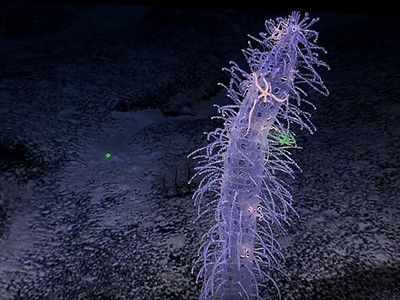
Deep-sea species are likely to be affected by seabed mining.Credit: SeaTops/Alamy
The controversial practice of mining the seabed for valuable minerals has taken a step forward after Norway became the first country to allow such exploration — disappointing scientists and environmental organizations who say that the method will irreversibly damage biodiversity and ecosystems.

Seabed mining is coming — bringing mineral riches and fears of epic extinctions
“This is about greed not need and will come at a significant cost to our environment for present and future generations,” says Matthew Gianni, co-founder of the Deep Sea Conservation Coalition, an advocacy group in Amsterdam.
On 9 January, Norway’s parliament voted 80–20 in favour of allowing mining on its continental shelf in the Norwegian sea to map and investigate whether sulfides and manganese crusts on the seabed in its national jurisdiction could be extracted profitably. These metals are currently mined on land.
The Norwegian government, which has been pursuing its mining plan since 2020, says that seabed extraction is necessary to ensure sufficient supplies of metals such as manganese and cobalt used in the manufacturing of electric-vehicle batteries and other electronics to help the transition to a low-carbon economy. But many scientists including the European Academies Science Advisory Council — a group of national science academies — say that this claim is misleading, and argue that terrestrial metal resources are sufficient.
Although research on the ecological impacts of deep-sea mining is limited, studies are beginning to show that it could harm species on the seabed by crushing them with machinery or smothering them with plumes of sediment that are kicked up by mining activities1. Scientists discovered that species in the water column such as jellyfish are also at risk. Many researchers and governments are calling for a moratorium until more is known about the deep-sea ecosystem.
Advice ignored
Table of Contents
The Norway vote means the government can issue permits to companies and other entities to explore a reported 281,000 square kilometers of the seabed. Permission to extract minerals for commercial activities will require a further parliamentary vote, but many scientists and environmental organizations see the vote as a gateway towards that goal.
Norwegian scientists say they are disappointed but not surprised by the move. They say that the government ignored their scientific advice and that of the nation’s environment agency in Trondheim. In response to a public consultation on the government’s mining plans, scientists said that too little is known about the biodiversity and ecosystem functions in the proposed sites to enable mining to go ahead safely.
“How can we make meaningful judgements of acceptable harm or risk when we know absolutely nothing about it?” says Peter Haugan, director of policy at the Institute of Marine Research in Bergen.
Helena Hauss, a marine ecologist at NORCE, an independent research institute with headquarters in Bergen, says that the proposed mining sites, which are like islands — inhabited by communities not found elsewhere — will be irreversibly destroyed. “This is difficult to align with the claim of the Norwegian government that this will be done in a sustainable and responsible way,” she says.
Environmental lawsuits
Haugan says that Norway’s decision could be illegal because the government lacked sufficient scientific evidence to assess the impacts of future mining activities, which is required under national law. He anticipates that environmental groups will launch lawsuits against the government on these grounds to try to stop mining from going ahead.
He is also concerned that the government will ignore science advice when requests for commercial exploitation are considered. The government suggests exploitation is around 20 years away, but environmental organizations say it could happen sooner.
Gianni says that companies who finance exploration of the seabed are likely to want commercial licences in return for their investments.
Norway’s push to open up its seabed for mining comes as international negotiations continue on whether to permit commercial harvesting of the sea floor in mineral rich areas outside of countries’ national jurisdiction, including the Clarion Clarion–Clipperton Zone (CCZ), a 4.5-million-square-kilometre area in the eastern Pacific Ocean between Hawaii and Mexico. Norway is one of the strongest proponents of deep-sea mining in the international discussions, says Gianni.
